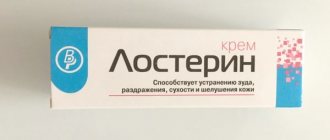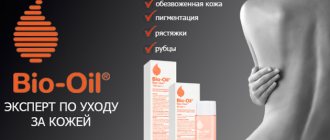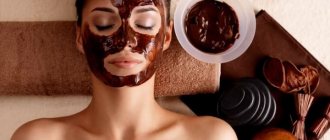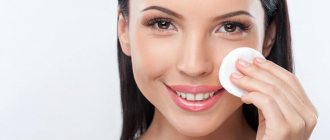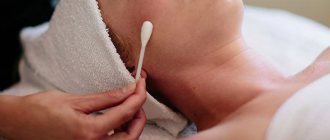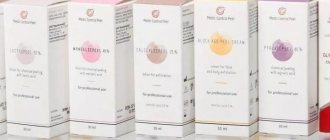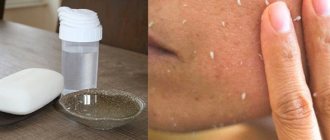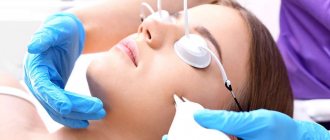How does a woman’s body change during breastfeeding?
Let's start, as they say, “from the beginning.” During pregnancy, a woman's body undergoes natural changes associated with the intrauterine development of the fetus. After giving birth, a young mother is in a stressful state. All internal organs and systems work “for two”. After all, a newborn baby has not yet formed its own immunity and exists solely at the expense of maternal resources.
The first thing a woman in this condition pays attention to is the deterioration of her appearance. After all, the reflection in the mirror for the fair sex has always been, is and will be a source of special pride or disappointment - depending on what is seen. Naturally, this affects the psychological state (the same notorious postpartum depression).
What provokes such changes:
- Both pregnancy and lactation are accompanied by changes in hormonal levels. Acne, rashes, oily skin, pigmentation may appear;
- diet. Mom is forced to adhere to a certain diet, in which her body does not receive enough nutrients (vitamins, minerals) that are necessary for the normal functioning of an adult. As a result, regeneration processes slow down, local and general immunity is weakened;
- lactation. The child “sucks from the mother” the microelements it needs. And against the background of insufficient intake of them into the body with food, the condition of the skin worsens doubly;
- Nervous overstrain associated with a woman’s natural worries about the baby’s condition and lack of sleep cause psychological responses. This could be irritation, bad mood, depression of varying severity. Plus, even the smallest defects and shortcomings of the figure, appearance, and skin condition are noticed.
And the young mother begins to think about how to help herself return to her former state. First of all, get your face in order.
An option to solve the problem is peeling during breastfeeding. Experienced cosmetologists claim that this procedure is not only a whim of a nervous mother, but also an indispensable attribute of effective skin care. You just need to choose the right way to influence the skin, taking into account individual indicators.
Laser lifting
Laser lifting is one of the types of lifting with thermal loading - a laser beam selectively burns dead cells. Against the background of exposure to the beam, blood circulation increases, and dead cells are quickly separated from the dermis. Recovery processes proceed quickly, the rejuvenating effect is noticeable after each session.
After the procedure, wrinkles become less noticeable. Active collagen production begins and elasticity returns. The laser does not cause discomfort, and recovery is relatively quick.
This type of lift can be done at any time of the year, because active sun does not affect the result. The procedure is suitable for any skin type, even the most sensitive. Laser can rejuvenate both large areas of the dermis and act selectively, for example, to remove a scar or scar.
Laser lifting is carried out using the following types of lasers:
- Neodymium. Eliminates vascular patterns.
- Diode. Used for skin tightening.
- Fractional. Deep peeling.
- Erbium. Elimination of fine wrinkles and smoothing of deep wrinkles.
Age
As a rule, laser rejuvenation is recommended at the age of 30-35 years - the production of one’s own collagen is still sufficient, wrinkles are shallow and the laser can effectively affect them. Each of us has an individual skin condition, so at the first meeting the cosmetologist will draw up an individual course program and choose a laser.
Forced action or postpartum depression
The birth of a baby is the greatest joy for a mother, but clogged pores, the appearance of a large rash, and ulcers on the face can overshadow the moments of oblivion. What can provoke such troubles?
- A special hormonal background is the main culprit of skin imperfections. Pregnancy and lactation cause numerous changes in the body. Only from the rearrangement of hormones can a mother have serious problems with her skin: it becomes oily, the pores instantly become clogged, and a lot of inflamed pimples and ulcers appear;
- Strict diet - the diet of a nursing mother before the baby is introduced to complementary foods (about 4-5 months) is very limited. Food that is poor in vitamins and mineral components weakens the immune system, the protection of skin cells, and slows down their functioning;
- With milk, a woman’s body also leaves important microelements, so their insufficient supply from food for the skin is doubly “painful”;
- Constant lack of sleep and imperfect body shape after childbirth cause nervous tension and depression. The nursing mother begins to notice the slightest defects on the skin - and becomes even more upset.
Cosmetologists advise new mothers not to give up and not wait until breastfeeding is completed. Skin problems need to be dealt with without delay. Of course, nothing can be done about hormones, but issues with a lack of vitamins, mineral components and clogged pores can be solved by proper skin care and regular cleansing.
Facial peeling while breastfeeding is not a whim of a nervous mother, but part of mandatory skin care. The main thing is to organize it correctly so as not to harm the baby. There is no need to store skin problems until the end of lactation, because it will be very difficult to correct them later.
For most peels, breastfeeding is a contraindication; we will not consider them. We will focus on peelings that are safe for the baby:
- Ultrasonic skin cleansing is a gentle hardware peeling technique. Ultrasound has a gentle effect on the skin, destroys dead cells and sebaceous plugs, normalizes the functioning of the sebaceous glands and stimulates metabolism in cells. Peeling is painless, but slight discomfort may still be present. The peeling procedure is quite popular, but ineffective, according to reviews from nursing mothers;
- Glycolic peeling – has a delicate effect on the skin, eliminates the problem of excessive oiliness, cleanses pores and smoothes the facial texture. Peeling with glycolic acid is painless, and you will be pleased with the results a few days after the procedure.
- Almond peeling is a variant of acid peeling for the face, which can also be used during breastfeeding. Mandelic acid has high cleansing, bactericidal and antioxidant effects. Peeling with this acid narrows pores and increases cell immunity, affects problematic rashes and increases the elasticity of fibers. For a young mother, such peeling will be a real godsend;
- Pyruvic peeling – the procedure belongs to a series of acid peels. The procedure seems to have been created for nursing mothers. The fact is that many women during pregnancy and after childbirth complain of extensive rashes on their faces. Pyruvic acid has a high healing effect, so it is often used to treat problematic acne and acne;
- Milk peeling is a favorite cosmetic procedure for women during lactation. Lactic acid helps cope with dryness and age-related defects. It gently affects problem areas, cleanses the skin and pores of dirt particles that prevent it from breathing fully and absorbing beneficial components from skincare products. Some of the lactic acid is already contained in the cells of the epidermis, so the risk of an allergic reaction, complications and all kinds of troubles after peeling is minimized;
- Mechanical cleaning - the procedure can be used during breastfeeding. However, nursing mothers should take into account that peeling is harmless, but painful and requires long-term rehabilitation.
Cosmetologists say that acid peeling can be done during lactation, but only superficially and exclusively under the guidance of a professional in a salon. If the skin is deeply exposed, the acid can enter the bloodstream and be passed on to the baby's milk, so such peelings should be avoided.
Allowed and alternative methods
So, is it possible to do peeling while breastfeeding? The answer will be that it is possible and even necessary. We are considering salon procedures that are allowed for a nursing woman.
- Ultrasonic cleaning is positioned as a harmless, gentle manipulation. When exposed to ultrasound, dead skin cells are removed, comedones and sebaceous plugs are destroyed, metabolism is improved, and internal processes in epidermal tissues are stimulated. The procedure is usually painless, although it may cause mild discomfort in this condition. According to reviews from nursing mothers, it is not always effective.
- Glycolic peeling is recommended for women with oily skin, enlarged and clogged pores. Under the influence of glycolic acid, the microrelief is smoothed. The result becomes obvious a few days after the session.
- Almond peeling is safe for a nursing mother. Mandelic acid has an antioxidant, bactericidal, cleansing effect. Increases local immunity, eliminates rashes, increases the elasticity of epidermal fibers.
- Pyruvic peeling is a procedure that is ideal for this period. Many mothers complain of rashes, irritation, acne, and purulent pimples. The acidic component in the exfoliant has a therapeutic effect and helps to cope with the listed problems.
- Milk peeling is characterized by the highest safety. Lactic acid is already present in skin cells, which reduces the risk of developing allergic reactions to almost zero.
- Mechanical cleaning is a fairly effective procedure, but can be painful due to an increased pain sensitivity threshold.
As an alternative, you can use homemade exfoliating peeling based on sugar and sour cream, sea salt and olive oil, cream and coffee grounds.
How does chemical peeling work?
Chemical peeling is a procedure during which the surface layers of the skin epithelium are removed with special means based on acids of varying concentrations.
We recommend reading: Glycine during breastfeeding
Accordingly, under the influence of these agents, the skin receives a chemical burn. Its depth depends on various factors, including the type and concentration of the acid, the duration of contact of the product with the epidermis, the individual sensitivity of the skin, etc.
The procedure is aimed at destroying the top layer of skin cells and stimulating the regeneration process. As a result, the skin is rejuvenated, unevenness and fine wrinkles are smoothed out. The face takes on a fresh and radiant appearance.
How is ultrasonic cleaning performed?
The procedure consists of several stages:
- The cosmetologist prepares the face: removes makeup, cleanses, applies a special mask to open the pores.
- The skin is covered with a special gel, which allows the ultrasound waves to work in the epidermis (they simply die out on dry skin), and also saturates the dermis with useful substances.
- Cleaning is carried out directly: the device for ultrasonic facial cleansing is equipped with a spatula (scrubber), which the cosmetologist moves over the face. The scrubber emits ultrasound waves and removes loose dirt. The device literally pushes dirt, sebaceous plugs, and cosmetic residues out of the pores.
- At the end of the manipulation, a soothing facial massage is performed, a restorative mask and moisturizer are applied.
Ultrasound rays have several types of effects on the dermis:
- mechanical - sound waves create pressure on tissues, massage them, increasing the conductivity of cellular structures;
- thermal - the heat of sound vibrations warms up the skin, it becomes softer, more elastic, and pliable;
- physico-chemical - ultrasound accelerates molecules, as a result of which metabolic processes in the epidermis proceed faster.
Types of chemical peeling
Peeling varies depending on the degree of impact:
- Surface. This is a gentle effect, since it affects the uppermost layer of the epidermis and removes dead cells. This cosmetic procedure helps to polish the skin of the face, smoothing out minor imperfections and removing age spots. Superficial peeling is also used if you want to get rid of acne and blackheads. This procedure can be performed by a cosmetologist.
- Median. Under the influence of acids, the stratum corneum of the skin is completely removed. This intervention is more serious and requires the participation of a dermatocosmetologist. Medium peeling is used to combat skin aging, the appearance and deepening of wrinkles, stretch marks, freckles and age spots.
- Deep. The epidermis of the skin is completely removed. The procedure is performed in a hospital setting and entails a longer recovery period. Indications for deep peeling are aging skin, deep wrinkles, acne, scars.
What means are used?
They resort to skin cleansing using special chemical compounds to improve complexion and remove various types of cosmetic defects. Chemicals eliminate old skin cells on its surface, and also penetrate into the next layers and force the body to activate the production of substances due to which the skin has good tone. This list includes:
- hyaluronic acid;
- collagen;
- elastin.
Superficial peeling using chemical agents is considered a harmless cosmetic procedure. To carry it out, various types of acids are used, including retinoic, glycolic, azelaic, phytic, and kojic.
Medium peeling requires a stronger acid – trichloroacetic acid. The burn affects the deeper layers of the skin and therefore the procedure is much more painful than superficial peeling. The healing period depends on how thin and sensitive the skin is, and on the regenerative potential of the body.
The deep chemical peel procedure requires the use of phenol. It is extremely painful and complete restoration of the skin takes some time, but the effectiveness of deep acid peeling is quite high.
What are the advantages?
Carbon peeling includes the effect of photorejuvenation and laser action. The main highlight of this technique is a cosmetic nanogel that penetrates deep into the layers of the skin, binds dead epidermal cells and removes sebum and dirt. Exposure to a laser beam helps destroy dead cells, destroys bacteria and has a beneficial effect on the production of elastin and collagen.
The main advantages of this method are:
- Absence of any discomfort. The procedure is completely painless. During the session, the client only feels heat from the laser beam.
- Versatility. The service is suitable for owners of any skin type and allows you to cope with several problems at once in one session.
- No inflammation. Most women are afraid of facial cleansing due to severe redness after the procedure. Carbon cleansing has an anti-inflammatory effect, which makes it possible not to cancel your business for that day.
- A complex approach. In just one session, you can solve several problems with the condition of the dermis, which is an undeniable advantage of this method.
- No recovery period. After the session, no additional days are needed to restore the epidermis. It is enough to use the right care, which will help your skin to be in perfect condition.
- The result lasts for a long period of time. The effect of the procedure can please its owner after the first time and last up to a year or more. It all depends on the condition of the dermis and the regularity of home care.
Why is it so harmful to peel during lactation?
Let us remember that peeling is a controlled, intentional damage to the skin of varying degrees of intensity, designed to activate the body’s internal reserves to renew the epidermis, get rid of defects and problem areas.
Peeling during lactation should, first of all, be safe for the baby. After all, he is defenseless against the outside world and exists only thanks to his mother’s “aura” (let’s call it that). But at the same time, it is necessary to take into account all of the above changes in the woman’s body.
Recently, peeling based on chemical compounds has become a popular cosmetic manipulation that can solve many different problems. It can be superficial (affecting only the upper ball of epidermal cells), middle (affecting deeper layers), deep (reaching the basal layer of the dermis).
Whether it is possible to do chemical peeling while breastfeeding depends on the type of procedure and the chosen chemical composition. Indeed, in all types of these procedures, among the contraindications and warnings, it is stated that they cannot be performed during pregnancy and breastfeeding. Let's look at the specifics.
- Medium and deep chemical peeling is a complete taboo for this period. Since the process uses aggressive components that enter the general bloodstream, they can harm the baby. After all, they will naturally end up in breast milk. If such “poisoning” for an adult body is not critical and often goes virtually unnoticed, then an imperfect child’s body is in serious danger.
- Superficial peeling is a gentle, soft procedure. The substances used are weak, in a concentration of no more than 10%. They act exclusively in the cells of the epidermis, without entering the general bloodstream. Therefore, they do not pose a threat to the baby. However, no cosmetologist can predict the reaction of the female body during this period.
- A woman may experience unpredictable allergic reactions against the background of unstable hormonal levels. Even those substances that were previously tolerated by the body absolutely normally.
Attention! There is no need to give up and wait for lactation to stop or reduce the time you feed your baby. There is an alternative, and there are also options for safe chemical peeling.
Hormonal changes
During lactation, as during pregnancy, a woman’s hormonal background is greatly changed. The skin reacts to hormone surges with dryness or vice versa – oiliness , allergic reactions, even to familiar cosmetics:
- rashes;
- the appearance of age spots;
- as well as decreased immunity.
We recommend: Features of chemical peeling for the face. Pros and cons of the procedure, rules of preparation and conduct
We recommend reading: Herbs to enhance breast milk lactation in women
Damage to the skin by peeling during this period may lead to the development:
- bacterial complications in the form of erysipelas or streptoderma;
- fungus - favus, trichophytosis;
- herpes.
These complications will have to be treated with serious medications, and it is possible that breastfeeding will be prohibited during this period.
The appearance of age spots
Women's skin, during lactation, is very photosensitive and prone to the appearance of age spots, even if exposure to sunlight is short-term.
Peeling will only increase the skin's sensitivity to the sun and pigmentation will most likely not be avoided.
Removing stains will be difficult and quite expensive, so it is better to do deep peeling only after breastfeeding , and if you really want to refresh your face, then use products based on fruit or lactic acids with a very low concentration of the active substance - less than 10%.
Harm to the child
In the first months of life, the baby’s body is not protected and is quite weak, so breast milk is the only source of nutrients and antibodies to various infections. If a dangerous substance enters the child’s body through breast milk, he may become ill or begin to develop worse.
Deep peels contain precisely those dangerous substances that clearly penetrate into the bloodstream and breast milk, so manufacturers and cosmetologists are against applying them to the skin of a nursing woman.
Important! The use of superficial peeling is allowed, but most of them contain retinoic and salicylic acids, which also enter the blood and milk, creating mild intoxication, which the mother’s body with a mature liver will not particularly notice, but this is not useful for the child. Therefore, from superficial peels you need to choose only completely safe ones.
Treatment of stretch marks after childbirth
Stretch marks are the most common problem that reminds a woman of pregnancy for a long time, usually throughout her life. It has been noticed that young girls under 25 years of age are more susceptible to stretch marks compared to older mothers, and the likelihood of stretch marks appearing during the first pregnancy is much higher than during subsequent ones.
However, today there is a real opportunity to combat stretch marks. Procedures such as mesotherapy, biorevitalization, and thermolifting of the body should be carried out with fresh stretch marks to maximize the reduction of the skin between stretch marks and narrow the stretch marks. Since stretch marks are a type of atrophic scar, they can only be removed using a series of laser resurfacing procedures, the number of which depends primarily not on the length, but on the width of the stretch mark and the healing ability of the skin. Laser resurfacing is possible after the end of the lactation period and complete stabilization of weight.
Harm to nursing mothers
Chemical peeling is harmful during breastfeeding not only for the baby, but also for the nursing mother. If a baby can only suffer from deep exposure, then women’s skin can react negatively to a superficial procedure. The problem is associated with a serious transformation of a woman’s hormonal background during pregnancy and after childbirth.
Expert opinion - Anastasia Zaslavskaya Dermatologist and cosmetologist, playing it safe, do not recommend even superficial peeling to breastfeeding patients, since they cannot predict the reaction of the body, in which hormones are raging, to acid exposure.
When the skin comes into contact with acids, age spots and other unpleasant formations may appear, which are difficult to remove. Certain chemicals help get rid of excess pigmentation, but they cannot be used during the lactation period due to possible harm to the baby. Unfortunately, a woman has to walk around with ugly skin until the end of the breastfeeding period.
Exceptions that prove the rules
However, some exfoliation procedures are prescribed from time to time for young mothers, but only under the strict supervision of a dermatologist-cosmetologist, since for most peelings, breastfeeding is included in the list of contraindications (see Table):
| PEELING FOR HB | EFFECT |
| Glycolic |
|
| Almond |
|
| Pyrovinogradny |
|
| Lactic |
|
| Ultrasonic |
|
| Mechanical |
|
For those who still dare to undergo peeling while breastfeeding (BF), doctors advise waiting at least the first 6 months, because the culmination of endocrine changes occurs in the second quarter after childbirth. After 9-12 months, hormones completely calm down, gradually returning to prenatal levels.
Safe alternative to chemical peels
Nursing mothers can choose more gentle salon procedures, or use folk recipes for facial cleansing. In the salon, a breastfeeding woman can be offered:
- Ultrasonic cleaning, soft, harmless, painless. Ultrasound affects only the superficial layer of the skin, removes dead skin cells, comedones, and normalizes metabolism in tissues.
- Mechanical cleaning, effective, but quite painful. The skin is treated with fingers or special instruments; no chemicals are used.
- Glycolic peeling. Ideal for oily skin, enlarged pores, and multiple comedones. Glycolic acid not only perfectly cleanses, but also smoothes out skin unevenness.
- Dairy is the safest. Human skin tissue contains its own lactic acid. That is, the substance is native to skin cells and does not cause an allergic reaction.
- Almond peeling. The active ingredient is mandelic acid, which has an antioxidant and antimicrobial effect. The result of the procedure is the elimination of rashes, strengthening of local immunity, increasing the firmness and elasticity of skin tissue.
- Pyruvic acid peeling is an excellent option for acne and ulcers. Women who have given birth often experience skin rashes due to hormonal changes. And pyruvic acid can easily cope with this problem.
At home you can use the following recipes:
- Vegetable peeling. Vegetables and herbs that contain a lot of acids are taken: tomatoes, sorrel, celery. Grind in a blender, apply to a clean face, hold for 5 minutes, rinse with warm water. After the procedure, the face is treated with the usual cream.
- Fruit. It is made according to the vegetable principle, only sour berries and fruits are used: currants, kiwi, citruses.
- Coffee. Kefir is mixed with coffee grounds. The resulting scrub is rubbed into the skin with light massaging movements and washed off with warm water. Next, use a moisturizer.
- Sugar. Sugar and sour cream are combined in equal proportions. The scrub is rubbed into the skin with soft massaging movements and washed off with warm water. Sour cream whitens, evens out tone, and grains of sugar remove dead skin cells.
We recommend reading: Recovery after a cesarean section: how to quickly recover after surgery, rehabilitation, what not to do - restrictions, heavy lifting, reviews
When visiting a beauty salon, be sure to notify the specialist about your status as a nursing mother. A specialist will select an effective and safe type of facial cleansing. Cosmetologists do not recommend going to them in the first six months after childbirth, since during this period hormonal changes are at their peak stage.
How to choose an ultrasonic cleaning device?
The choice of portable ultrasound devices is large. To choose the best one for yourself, you should consider the following parameters:
- vibration frequency of ultrasonic waves - the result of the procedure mainly depends on this characteristic; in professional devices it averages from 24 to 30 kHz; in a home model, the frequency should be close to these values;
- power - it gives the depth of penetration of waves into the skin; focus on 0.5-2 W;
- operating modes - the more there are, the more accurately you will find the one that suits your skin;
- additional functions – the more procedures you can perform using the device, the better; some models perform microcurrent rejuvenation, iontophoresis, galvanic lifting and other useful manipulations;
- battery, weight and size - these parameters make the device convenient to use;
- brand recognition - a reputable manufacturer guarantees the safety and uninterrupted operation of the product.
Can I use home remedies while breastfeeding?
You can also prepare a safe peeling at home:
- From sour cream and sugar . Preparation: mix 1:1 sour cream and sugar. Application: gently rub the mixture into the skin of the face, moving along the massage lines.
- From fruits . Preparation: grind lemon, green grapes, kiwi and currants in a blender in equal proportions. Application: cleanse face with tonic, apply peeling, rinse with warm water after 5 minutes, and finally moisturize with cream.
- From fruits and cereals . Preparation: grate the pulp of an apple or peach on a fine grater, and then mix with oatmeal ground in a blender. Application: cleanse your face with tonic, apply the fruit-cereal mixture as a face mask, and when it starts to sting, rinse with water.
- Coffee-kefir . Preparation: take 50 ml of curdled milk or kefir and mix with 15-20 g of coffee grounds. Application: rub the mixture with massage movements for about a minute, then rinse with warm water.
- From vegetables.Preparation: grind sorrel, sauerkraut and tomatoes in equal proportions in a blender. Application: rub into face previously cleansed with tonic, apply the mixture, and rinse after 5 minutes.
Reference . You can make a decoction of celery or parsley, freeze them in ice cube trays and wipe your face morning and evening.
Rules for the use of peeling during lactation
In order for the result to be useful and not harm the mother and child, you need to remember a number of rules:
- You should not use acidic salon peels. Especially salicylic and yellow.
- Before the procedure, consultation with a specialist is required.
- It is better to do an allergy test before using any product.
- You should not hope for a specific effect due to hormonal changes in the body.
- The procedure must be performed strictly according to the rules.
- It’s not just skin health treatments that are important. Her beauty and health depend on a set of actions: stable sleep, maintaining water balance in the body, and the absence of stress.
Experts and manufacturers of special products do not recommend chemical peeling while breastfeeding.
And if a woman suffers from serious skin problems and is ready to take risks, it is worth following clear rules for peeling during lactation.
You can also try to achieve the effect by adjusting your sleep and diet. Or resort to safer folk remedies.
Summary
To summarize: chemical peeling during lactation is not as harmful as it might seem at first glance. BUT... Only if the procedure is performed by an experienced cosmetologist, taking into account all individual characteristics.
Important! Be sure to tell your doctor that you are breastfeeding. It would not be amiss to mention how much time has passed since the birth. And feel free to answer questions, even if they seem a little inappropriate. Believe me, this is not idle curiosity, but a professional approach.
Checklist from cosmetologists for peelings during breastfeeding
So, in order not to be disappointed with the result of the procedure (that is, not to harm the baby and not get the opposite effect), it is worth understanding the following immutable truths:
- Salon acid peels (especially yellow and salicylic) are prohibited;
- In any case, a doctor’s consultation is necessary before the procedure;
- Hormonal changes do not guarantee any lasting effect;
- A preliminary allergy test for tolerance to the components of a particular drug is more important than ever;
- It is more important than ever to strictly follow the procedure protocol;
- It is better not to put off solving problems with appearance: neglected situations will require even more effort;
- You should approach skin health in a comprehensive manner: put your nerves in order, balance your sleep and nutrition, drink enough water.
Before after
Carbon facial peeling
Prices for carbon facial peeling procedures
| Name of procedure | Duration of the procedure | Cost ₽ |
| Carbon peeling face | 60-70 minutes | 4 000 |
| Carbon peeling neck | 20-30 minutes | 2 000 |
| Carbon peeling neckline | 20-30 minutes | 2 000 |
| Carbon peeling face+neck+décolleté | 70-80 minutes | 7 500 |
| Carbon back peeling | 80-120 minutes | 8 500 |
His cosmetic clinic is located in Strogino, come for a free 15-minute consultation. To get more information about our carbon peeling and to order a consultation today, make an appointment by calling +7 985 233-00-25.
What will cosmetologists say?
The advice of cosmetologists on peelings during breastfeeding is as follows:
- It is strictly not recommended to do acid peeling on your own;
- It should be taken into account that the peak of hormonal changes occurs 3-6 months after birth. As he approaches the age of one year, he approaches the prenatal indicator;
- before using any composition (including alternative means), it is necessary to do a tolerance test;
- strictly follow the post-care rules recommended by a specialist;
- be prepared for the possibility of unpredictable consequences - pigmentation, the appearance of mycoses, exacerbation of herpes. If the procedure is performed by an experienced cosmetologist, he can foresee such complications. Conclusion - we trust only professionals.
And most importantly, there is no need to delay solving problems that have arisen and putting off solving them until after feeding. After all, there are cases when correcting the situation “later” will be very difficult, and sometimes almost impossible.
- https://faceandcare.ru/piling-pri-grudnom-vskarmlivanii/
- https://eksfoliaciya.ru/telo/piling-grudnom-vskarmlivanii.html
- https://vskormi.ru/mama/himicheskij-piling/
- https://PilingSkin.ru/eksfoliatsiya/pri-grudnom-vskarmlivanii
- https://ProLitso.ru/piling/pri-gv
- https://VsePilingi.ru/kak-vybrat/piling-pri-grudnom-vskarmlivanii
- https://PitanieDeti.ru/vskarmlivanie/kormjashhaja-zdorovaja-i-krasivaja-mama/piling-pri-grudnom-vskarmlivanii.html


